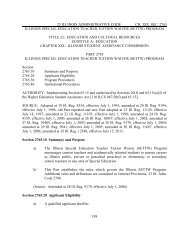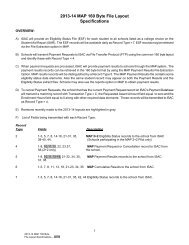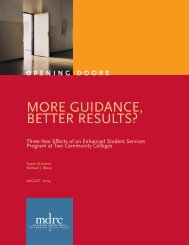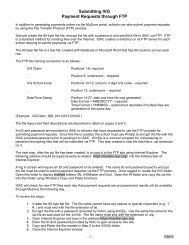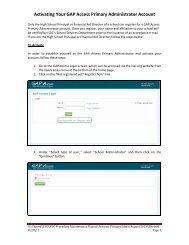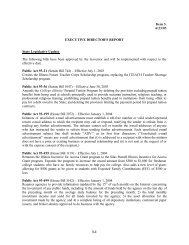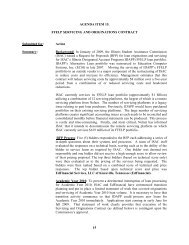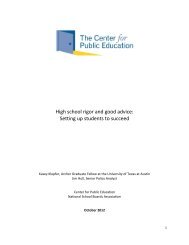Development of a Student Tracking Database for Program Evaluation
Development of a Student Tracking Database for Program Evaluation
Development of a Student Tracking Database for Program Evaluation
You also want an ePaper? Increase the reach of your titles
YUMPU automatically turns print PDFs into web optimized ePapers that Google loves.
AGENDA ITEM 11.<br />
DEVELOPMENT OF A STUDENT TRACKING DATABASE<br />
FOR PROGRAM EVALUATION<br />
Submitted <strong>for</strong>:<br />
Summary:<br />
In<strong>for</strong>mation<br />
In recent years, Illinois higher education “goal posts” have changed. The need <strong>for</strong> a<br />
better educated work<strong>for</strong>ce coupled with severe state financial constraints have<br />
shifted the focus on higher education from increased access to college to increasing<br />
completion <strong>of</strong> post-secondary programs leading to significant credentials –<br />
certificates, associate’s degrees or bachelor’s degrees.<br />
Along with this shift in focus comes the need <strong>for</strong> better student tracking data.<br />
Nationally there is new interest in tracking students from kindergarten through postsecondary<br />
education; the federal government is making aid contingent upon doing<br />
so. Illinois is in the process <strong>of</strong> developing a longitudinal data system (LDS) capable<br />
<strong>of</strong> tracking each student from kindergarten through post-secondary education and,<br />
perhaps, beyond that. However, the Illinois LDS is years away from completion.<br />
We can’t wait <strong>for</strong> the LDS to be completed. ISAC has started many new initiatives,<br />
some costing millions <strong>of</strong> dollars, which need to be tested, evaluated, and modified as<br />
the programs continue. We also need to be able to provide the legislature with<br />
evidence <strong>of</strong> the effectiveness <strong>of</strong> the Monetary Award <strong>Program</strong> (MAP.) Showing<br />
increased access <strong>for</strong> low income students is no longer sufficient to justify the<br />
considerable funding the program receives. Legislators want data on completion –<br />
how many degrees and certificates they are getting <strong>for</strong> the dollars spent on the<br />
program.<br />
It is possible to assemble a proxy <strong>for</strong> the LDS that ISAC can use to track changes in<br />
benchmarks <strong>of</strong> interest. Using school data from Illinois State Board <strong>of</strong> Education<br />
(ISBE), the National Center <strong>for</strong> Education Statistics (NCES), and our internal unit<br />
record HSSP/ACT, Outreach and FAFSA databases we can track ISAC outreach<br />
interventions, grade to grade enrollment attrition, high school graduation rates,<br />
FAFSA completion rates, and some college continuation rates. Using another<br />
statewide database, the shared enrollment database housed at SIU, we can pick up all<br />
students attending public universities, community colleges and track their progress<br />
toward completion. For students who attend private colleges, we can use the<br />
National Clearinghouse dataset and pick up graduation rates from that.<br />
11
By combining these data sets, cohorts <strong>of</strong> students can be tracked grade by grade<br />
from 9 th grade to 12 th grade. In 11 th grade we can establish unit record data using the<br />
HSSP/ACT database. In 12 th grade, we match to another unit record data source, the<br />
FAFSA database. We can track all MAP recipients individually as they use up their<br />
135 MAP paid credit hour allotments. As non-MAP recipients progress through<br />
college, we can track those that fill out FAFSAs as they move through public or<br />
private colleges. We can establish college graduation rates by income level,<br />
MAP/non-MAP recipient status, generation status, ACT score, or high school/<br />
postsecondary school and/or postsecondary school sector. While the per<strong>for</strong>mance<br />
variables will not be a perfect match to statewide numbers from a unit record data<br />
system, any change seen in these variables will be a good indication <strong>of</strong> changes in<br />
per<strong>for</strong>mance <strong>of</strong> the system overall.<br />
Action requested:<br />
None


